VER’s 1 January–30 June 2018 return 0.5%; five-year annual return 6.4%
Published 2018-08-20 at 13:47
Investment environment
The return on the State Pension Fund’s investments turned positive during the second quarter of 2018. The market value return from 1 January to 30 June was 0.5 per cent. The five-year average returnrose to 6.4 per cent in nominal terms and 5.8 per cent in real terms, which is excellent.
While the world economy continued to grow, its peak seems to have passed in several economic regions. The emerging trade war undermined the market sentiment during the second quarter.
Over the same period, the equity market developed favourably in the United States in which companies posted record-high profits propelled by fast economic growth and tax cuts. The Finnish equity market also performed well, even though the trend was reversed in late spring. In Europe and the emerging markets the returns were lower.
The fixed income markets were under pressure in early 2018. The emerging market bonds that have performed excellent over the past few years have suffered as a result of interest rate hikes in the United States and the impending trade war.
VER’s returns on investments
Future monitoring and evaluation of the State Pension Fund’s investment activities will increasingly focus on long-term outcomes and future prospects instead of quarterly reporting. However, VER will continue to post quarterly figures and comments to the same extent as previously.
On 30 June 2018, VER’s investment assets totalled EUR 19.4 billion. In the first half of the year, the return on investments at fair values was 0.5 per cent. The average nominal rate of return over the past five years (1 July 2013–30 June 2018) was 6.4 per cent and the annual ten-year return 5.7 per cent. Since 2001 when VER’s activities assumed their current form, the average rate of return has been 5.5 per cent.
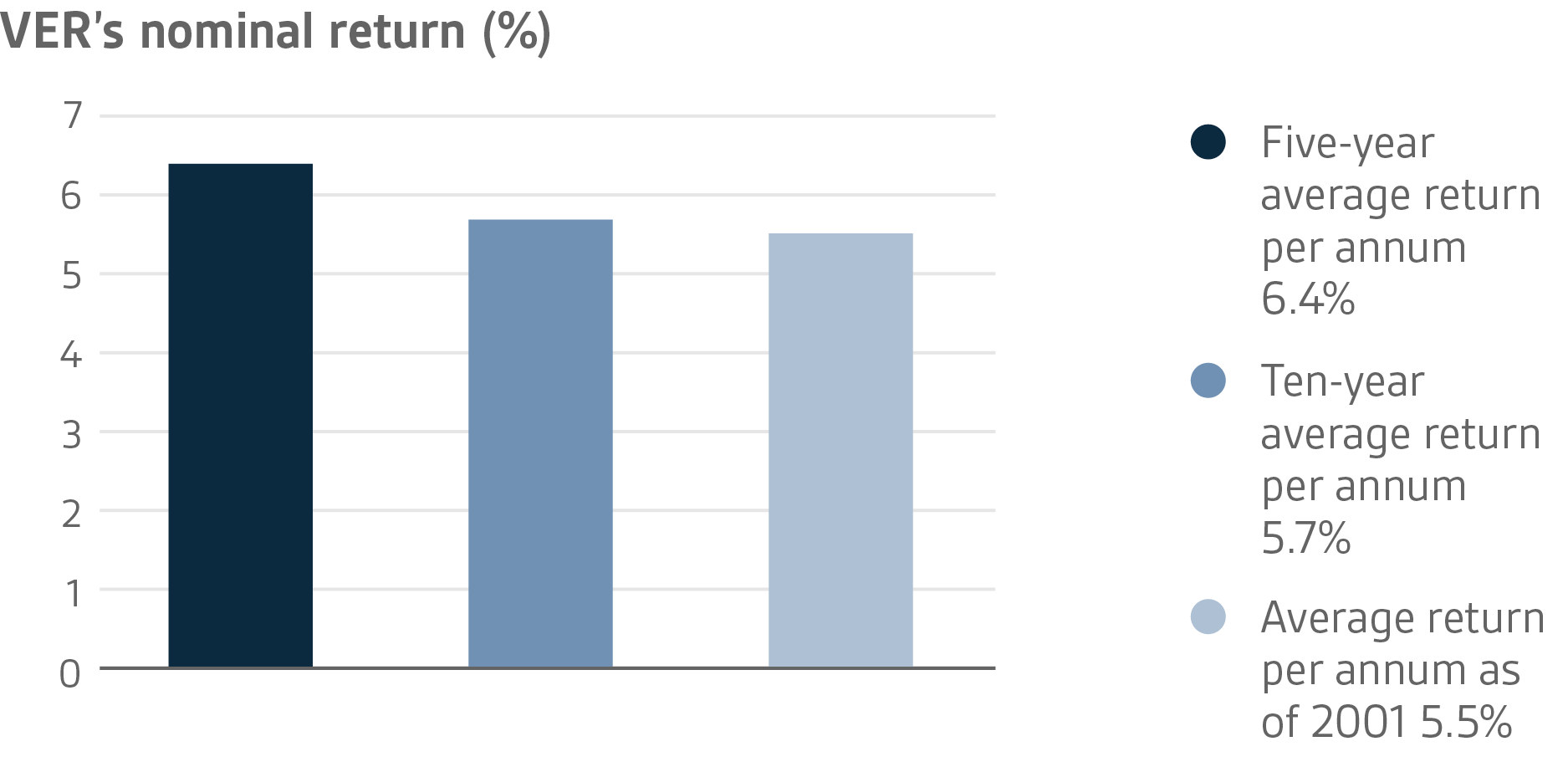
The real rate of return during the first six months of the year was -0.3 per cent. VER’s five-year average real return was 5.8 per cent and ten-year real return 4.5 per cent.
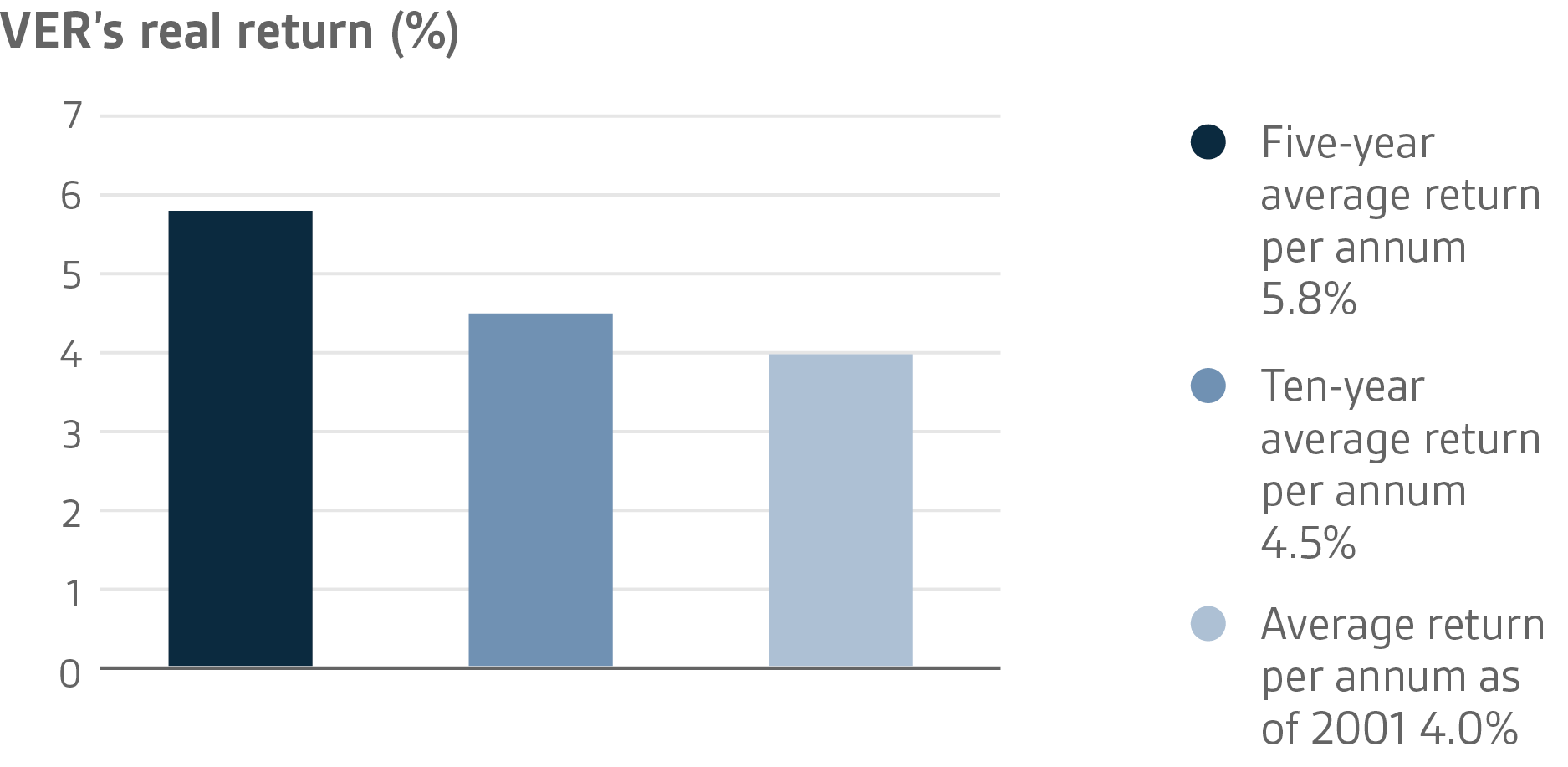
From the state’s point of view, it is pertinent to compare the return on investments with the cost of net government debt because the funds accumulated in preparation for future pension expenditure can be deemed to reduce such debt. Over the past ten years (1 July 2008–30 June 2018), VER’s average annual rate of return has beaten the cost of net government debt by 2.4 percentage points. Since 2001, the total market-value returns earned by VER have exceeded the cumulative average cost of equivalent government debt by about EUR 5.8 billion over the same period.
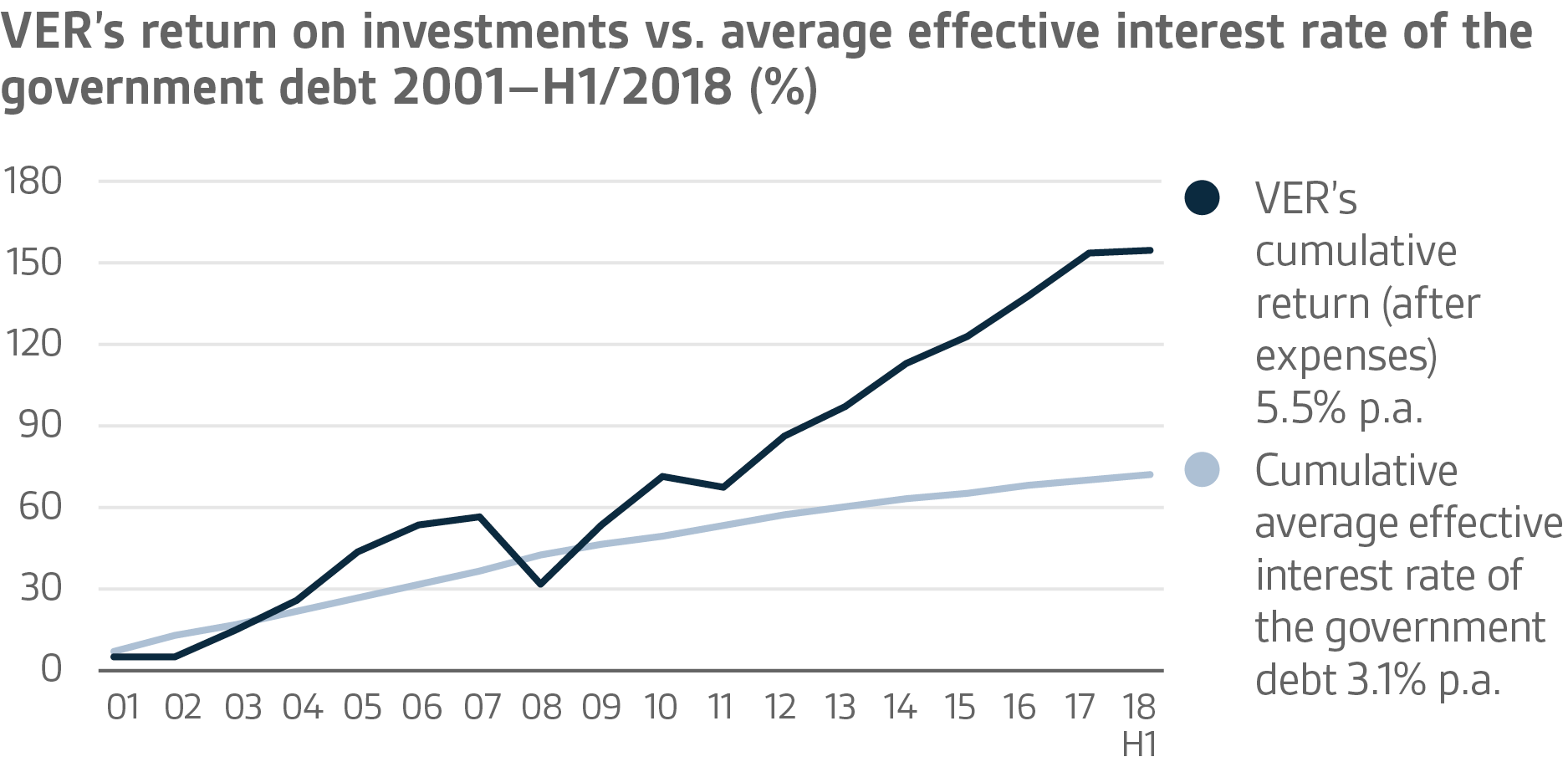
VER monitors long-term return relative to overall market developments by comparing the actual return with a global index in which the weight of both equities and currency-hedged bonds is 50 per cent.
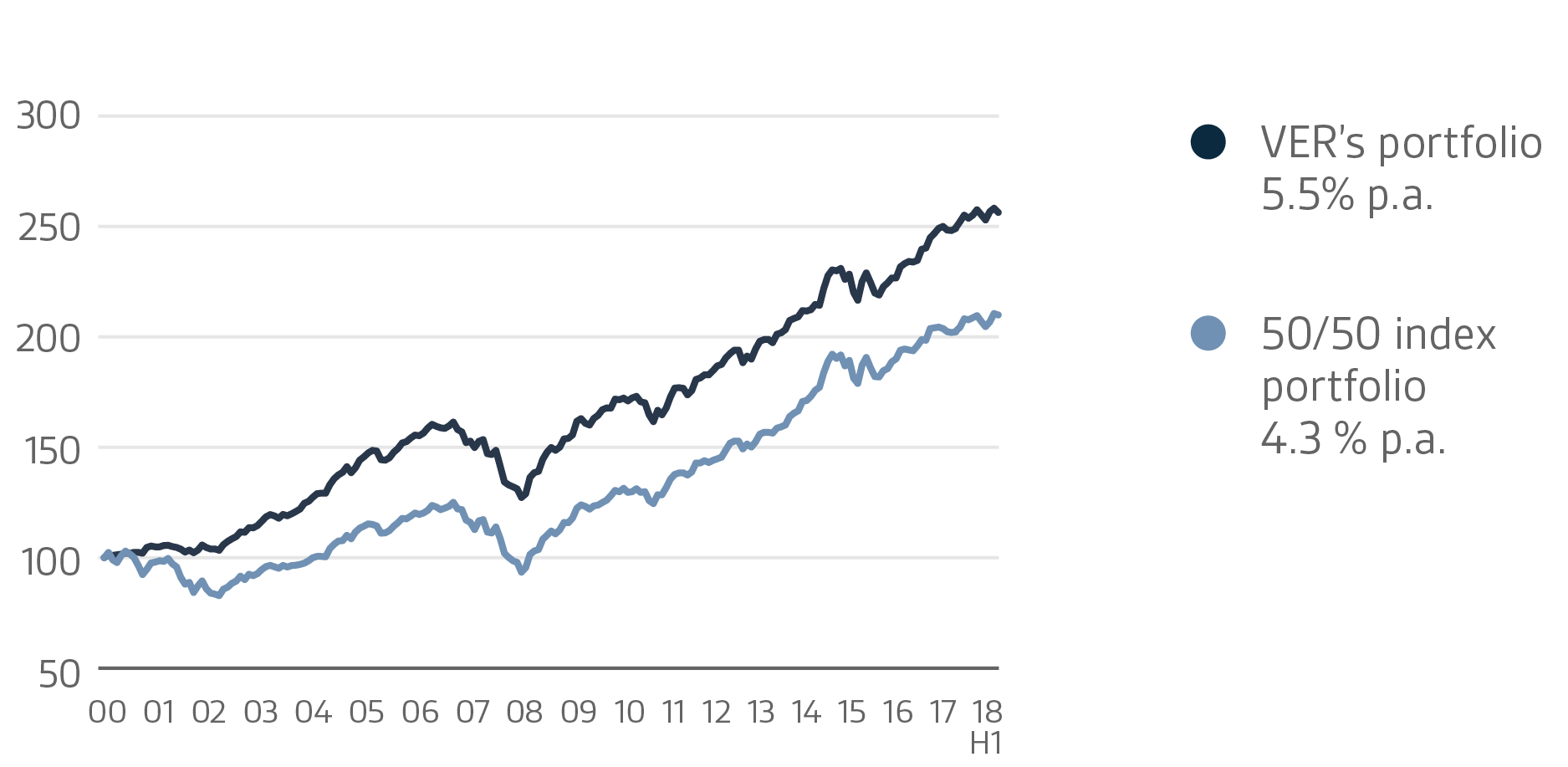
A closer look at January–June 2018
In accordance with the directive of the Ministry of Finance, VER’s investments are divided into fixed income investments, equities and other investments. At the end of June, fixed incomeinvestments account for 38.3 per cent, equities 47.7 per cent and other investments 9.9 per cent of the total. Of the large asset classes, liquid fixed income investments generated a return of -1.6 per cent and listed equities 1.8 per cent during the first half of the year. VER’s investments reached a 1,5 per cent return in the second quarter of the year.
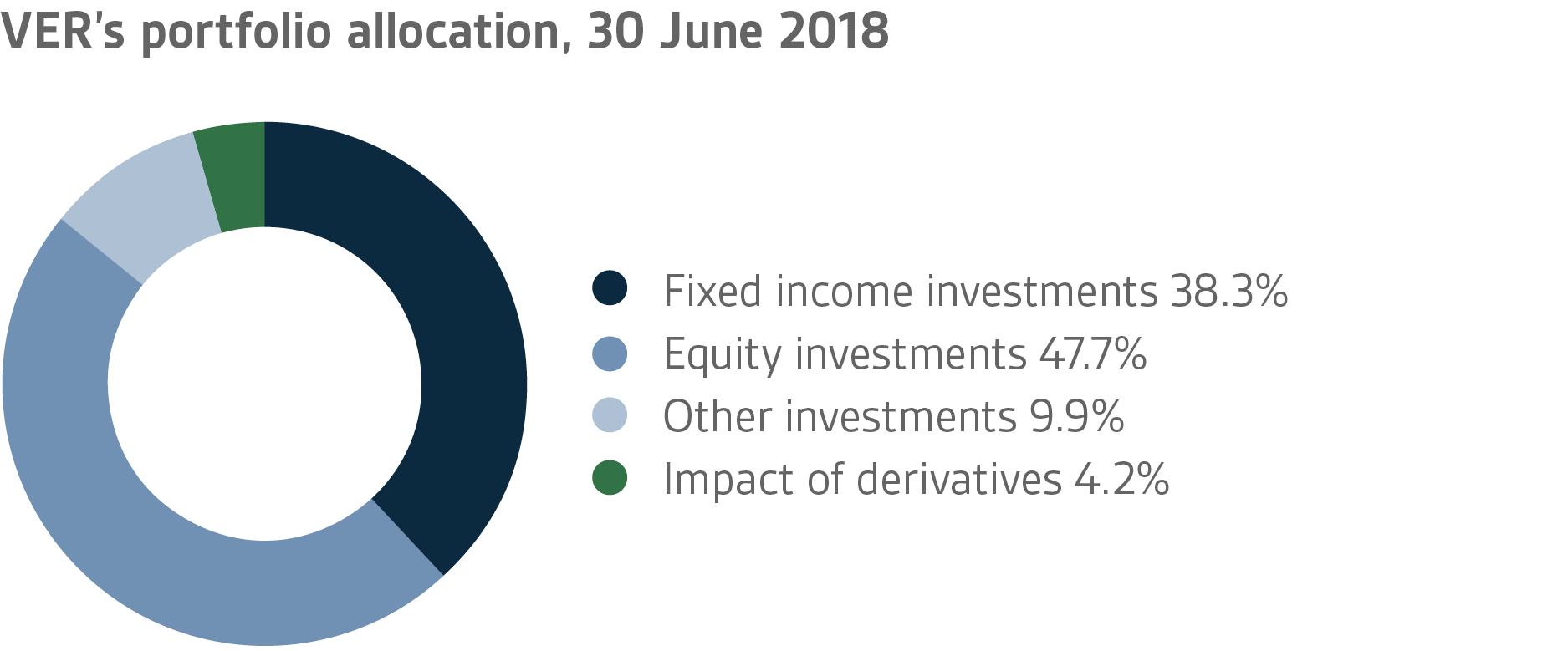
FIXED INCOME INVESTMENTS
Liquid fixed income investments
Liquid fixed income investments gave a return of -1.6 per cent.
During the first few months of the year, the interest rates increased sharply as investors expected inflation to accelerate, particularly in the United States following the tax cuts, and central banks to continue to tighten their monetary policies. The risk premiums on corporate loans increased clearly from the previously extremely low levels. The emerging markets suffered from raised U.S. interest rates and the stronger dollar. Additionally, fears of a trade war shook the markets.
In May, the political situation in Italy sharply increased the interest rate on Italian government bonds, causing investors to seek a safe haven in German and U.S. government papers. Before the end of the quarter, the interest rates were only restored to a limited extent following the turbulence in May.
In June, the United States Federal Reserve raised its refinancing rate by 0.25% implying two further hikes in 2018 and three in 2019. The European Central Bank EXB, for its part, decided to continue its monthly net asset purchases with EUR 15 billion from September to December and let it be understood that its benchmark rates will remain unchanged at least until autumn 2019.
Poor performance by emerging market debt in particular made a dent in the earnings on liquid fixed income instruments.
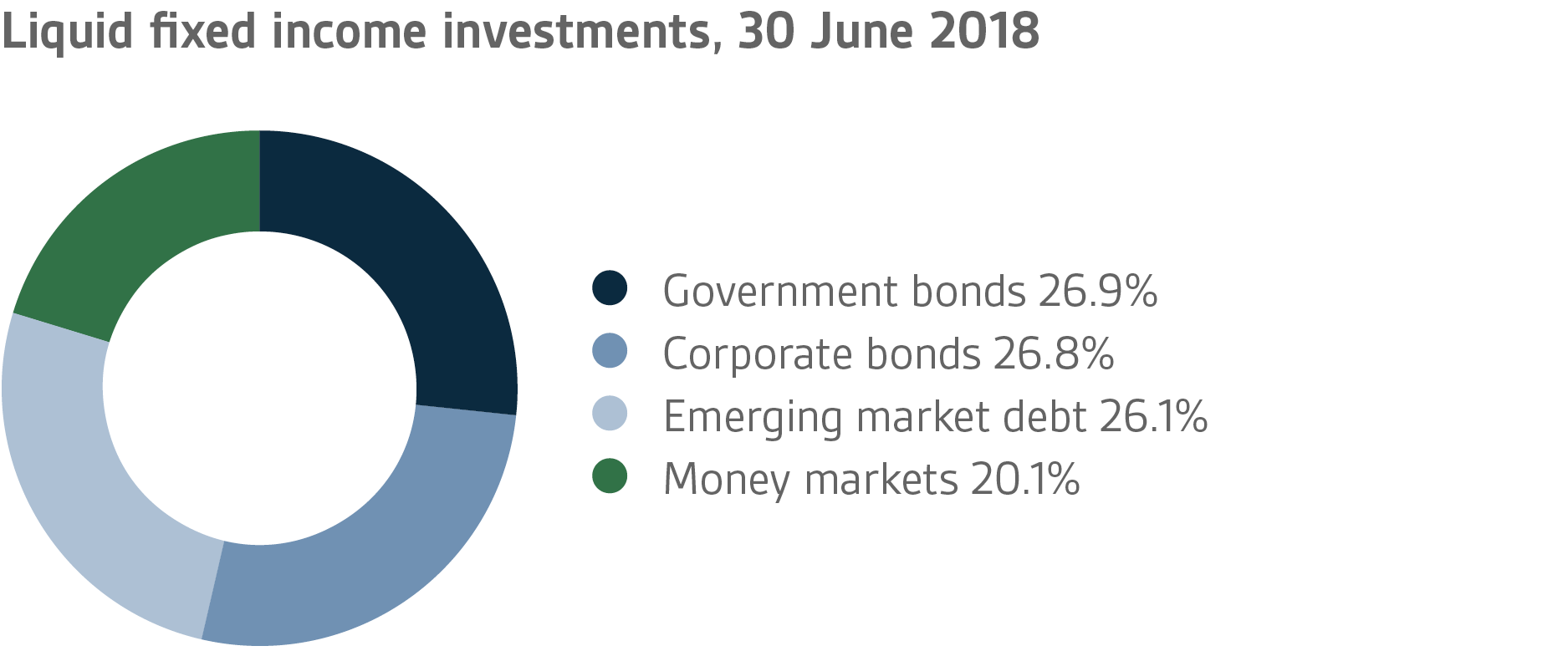
Other fixed income investments
Other fixed income investments include investments in private credit funds and
direct lending to companies.
Other fixed income investments yielded a 1.5 per cent return.
Concerns over the overheating of the private credit market continued. The debt leverage was used even more than before the financial crisis, especially in the transactions concluded by private equity and infrastructure funds. At the same time, some of the debt contracts made by the funds involved a greater risk for the funds than in previous years. However, VER’s private credit funds gave a healthy return of 3.1 per cent.
EQUITIES
Listed equities
The return on listed equities was 1.8 per cent.
The mood in the equity market varied greatly during the first half of the year. While 2018 began on a positive note, the mood changed dramatically in early February when U.S. interest rates took off, as the macro indicators published at that time suggested that inflation would increase. The equity markets calmed down slightly towards the end of the month, but nerves were on edge again in March when the trade policy measures contemplated by the President were disclosed. A number of twists and turns were experienced in the spring and the mood kept changing in response to new information. However, the sentiment in the equities market remained mostly upbeat for the rest of the spring, and the return on VER’s equity portfolio turned positive during the second quarter. VER earned its best returns on the Nordic and North American markets, and Finnish equities, in particular, gave a fine return during the first half of the year.
The impending trade war has been one of the overriding themes in the equities market, and many of the developments have been unprecedented. While most of the measures announced by the United States have targeted China, other countries and economic regions have not been spared. Few disagree that the outbreak of a major trade war would be highly damaging to the global economy. It remains to be seen how far the situation will escalate before any hoped-for relief is felt. After all, the sentiment in the stock market has remained surprisingly positive considering the threat of an extensive trade war. Listed companies have grown strongly, especially in the United States, which has sustained the market despite high valuation levels.
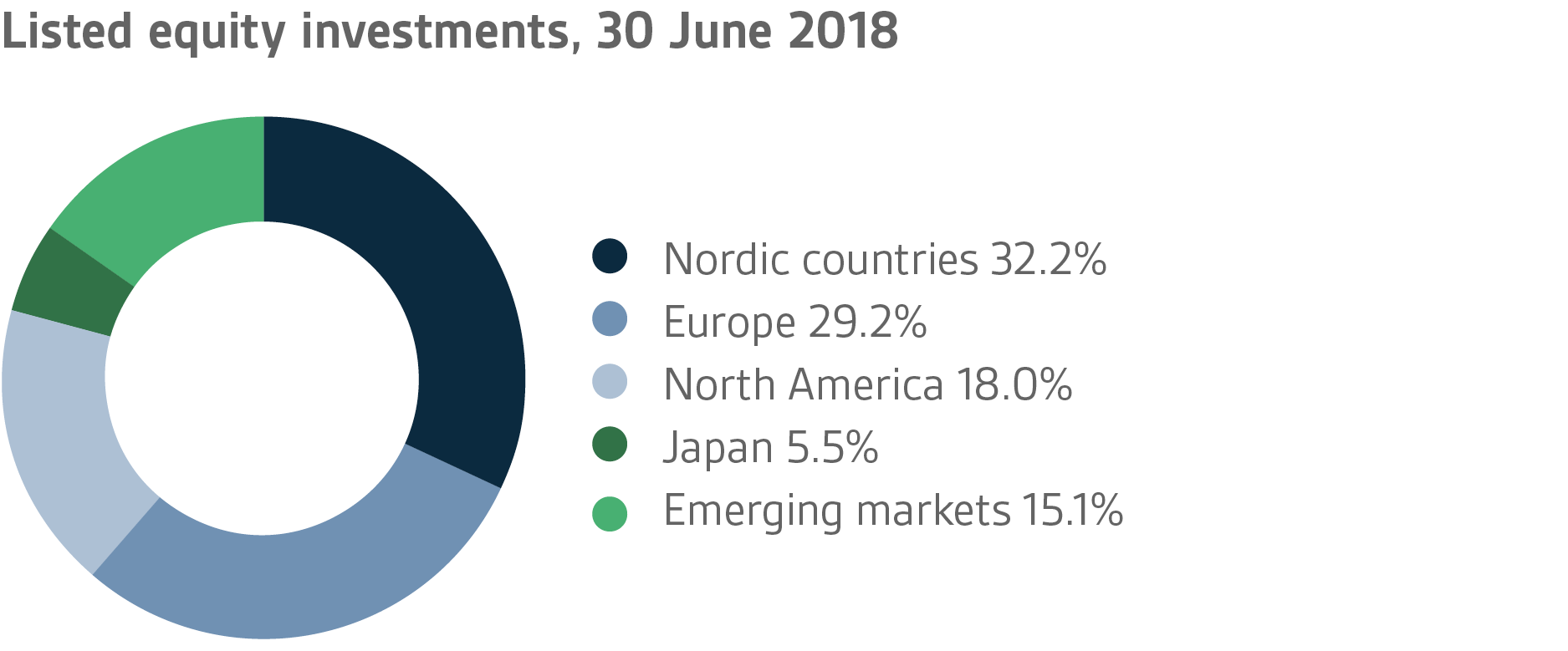
Other equity investments
VER’s other equity investments include investments in private equity funds, non-listed stock and listed real estate investment trusts.
Private equity investments returned 9.0 per cent, unlisted equities 3.0 per cent and listed real estate investment trusts 0.8 per cent.
In private equity investments, the positive trend continued during the first half of the year. Underlying these good performances are successful exits made by managers at high valuation levels and a continued increase in the marketing capitalisation of the portfolio companies. However, there are growing uncertainties because of high valuation levels and companies’ rising debt ratios.
The positive return on listed real estate investments during the second quarter followed the trends in the listed equity markets.
OTHER INVESTMENTS
VER’s other investments are in unlisted real estate, infrastructure, hedge funds and risk premium strategies.
The return on real estate funds was 3.4 per cent while infrastructure investments yielded 4.7 per cent.
As in the previous year, the sentiment in the real estate and infrastructure investment market remained positive. Good returns in both asset classes were due to successful exits and increased valuation levels.
Hedge funds yielded a return of 0.2 per cent in the first half of the year. The biggest returns were earned on macro funds. For funds focusing on quantitative modelling and emerging markets, the early part of 2018 was challenging.
The return on risk premiums during the first half was -5.7 per cent. So far, the current year has been extremely difficult for this asset class. Value strategies, in particular, have experienced a major fall in value during the first half of the year.
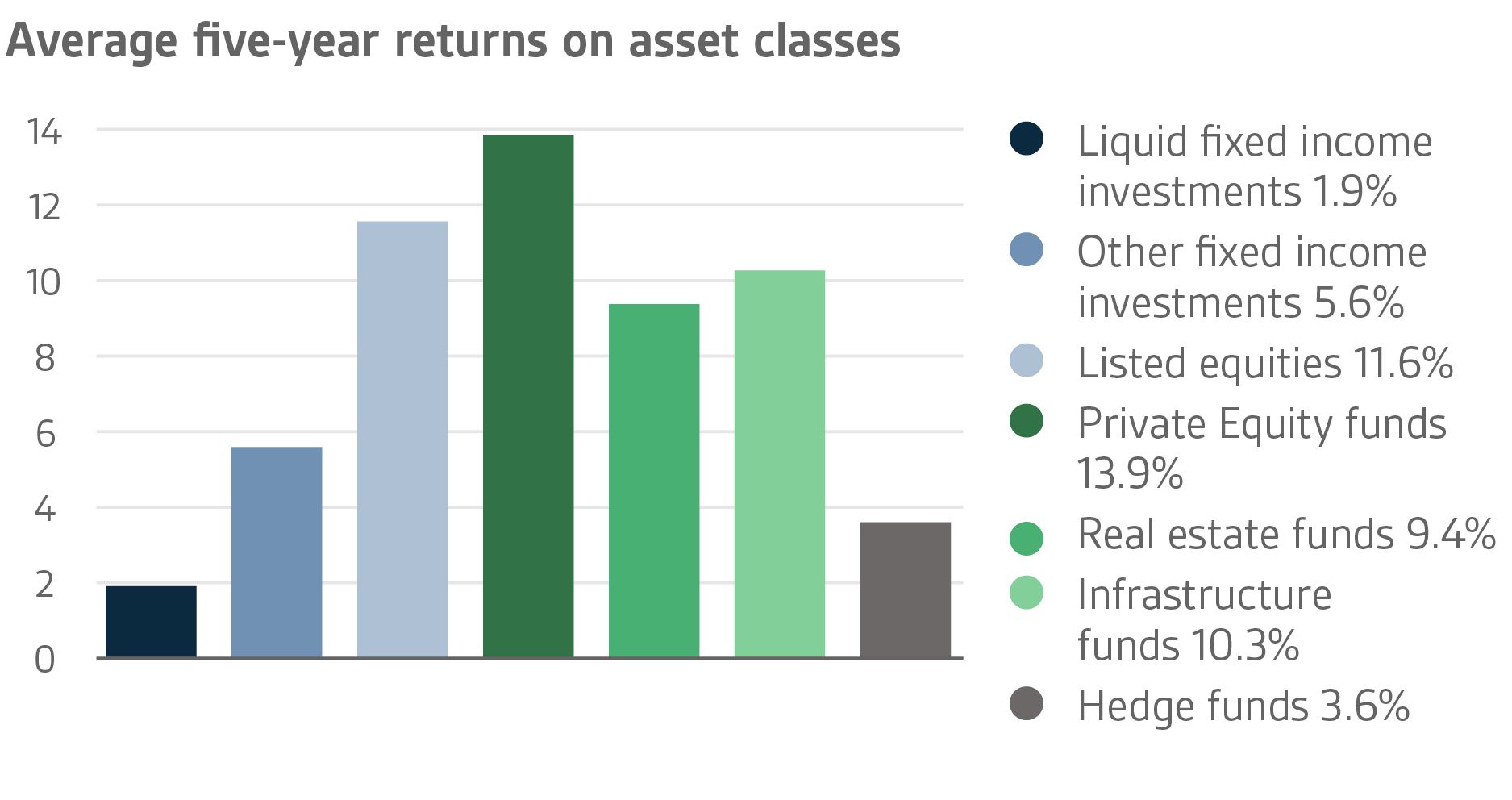
The state’s pension expenditure continues to increase
The State Pension Fund’s role in balancing government finances has grown and will continue to do so. In 2017, the state’s pension expenditure totalled approx. EUR 4.6 billion while the 2018 budget foresees an expenditure of nearly EUR 4.7 billion. As VER contributes 40 per cent towards these expenses to the government budget, the transfer to the 2018 budget amounted to close to EUR 1.9 billion. During the first half of the year, VER transferred EUR 933 million to the government budget. Over the same period, VER earned a total of EUR 723 million in pension contributions.
In June 2016, the Board of Directors of the State Pension Fund adopted a strategy that defines its long-term objectives in greater detail. The strategy foresees that the 25 per cent funding ratio target specified by law will be attained by 2033, if not earlier. To achieve this, it is imperative that VER’s pension contribution income remains at the estimated level and that the real return on investments remains relatively high. As the state’s pension liabilities amounted to EUR 92.6 billion at the end of 2017, the funding ratio was approx. 21 per cent. Additionally, the strategy sets out the principles by which the risk level and basic allocation of the investment portfolio are derived from the target funding ratio established for VER.
|
KEY FIGURES
|
|
|
| |
30.6.2018
|
31.12.2017
|
|
Investments, MEUR (market value)
|
19 433
|
19 586
|
|
Fixed-income investments
|
7 441
|
7 890
|
|
Equity investments
|
9 263
|
9 308
|
|
Other investments
|
1 915
|
1 860
|
| |
|
Breakdown of the investment portfolio
|
|
Fixed-income investments
|
38,3 %
|
40,3 %
|
|
Equity investments
|
47,7 %
|
47,5 %
|
|
Other investments
|
9,9 %
|
9,5 %
|
|
Impact of derivatives
|
4,2 %
|
2,7 %
|
| |
| |
1.1.-30.6.2018
|
1.1.-31.12.2017
|
|
Return on investment
|
0,5 %
|
6,6 %
|
|
Fixed-income investments
|
|
Liquid fixed-income investments
|
-1,6 %
|
2,0 %
|
|
Other fixed-income investments
|
1,5 %
|
7,3 %
|
|
Equity investments
|
|
Listed equity investments
|
1,8 %
|
11,0 %
|
|
Private Equity investments
|
9,0 %
|
15,6 %
|
|
Other investments
|
|
Real Estate funds
|
3,4 %
|
7,4 %
|
|
Infrastructure funds
|
4,7 %
|
14,8 %
|
|
Hedge funds
|
0,2 %
|
4,8 %
|
| |
|
Pension contribution income, MEUR
|
723
|
1 427
|
|
Transfer to state budget, MEUR
|
933
|
1 827
|
|
Net contribution income, MEUR
|
-210
|
-401
|
|
Pension liability, MEUR
|
|
92 600
|
|
Funding ratio
|
|
21 %
|
Inquiries: Additional information is provided by CEO Timo Viherkenttä, firstname.lastname@ver.fi, tel.: +358 (0)9 2515 7010.
Established in 1990, the State Pension Fund (VER) is an off-budget fund through which the state prepares to finance future pensions and equalise pension expenditure. VER is an investment organisation responsible for investing the state’s pension assets professionally. At the end of June 2018, the market value of the Fund’s investment portfolio stood at EUR 19.4 billion.
All figures presented in this interim report are preliminary and unaudited.